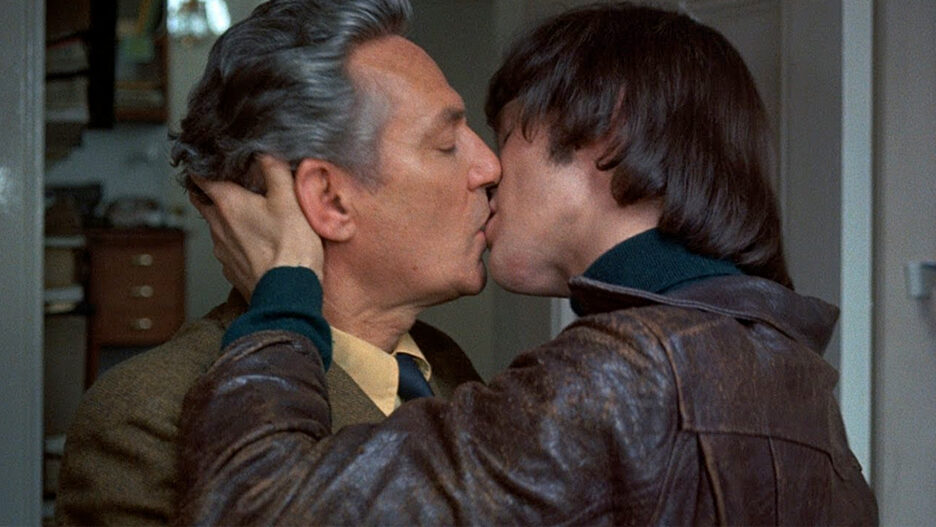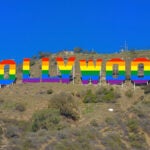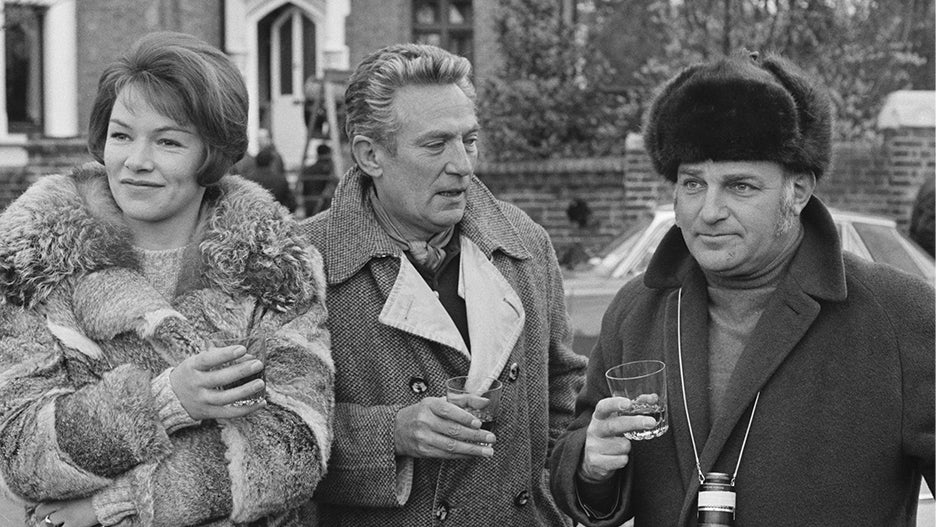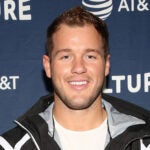Inside That 50-Year-Old Same-Sex Kiss in 'Sunday Bloody Sunday' (Guest Blog)
“I didn’t think that it should be portrayed with any kind of apology,” director John Schlesinger said of Peter Finch and Murray Head’s lip-lock in 1971 film
Peter Finch and Murray Head lock lips in “Sunday Bloody Sunday” (United Artists)
John Schlesinger decided not to attend the Academy Awards in 1970, even though his film “Midnight Cowboy” had been nominated for Best Picture and he was up for Best Director. On the evening of April 7, 1970, otherwise known as Oscar night, the British director remained in London with his American boyfriend, the photographer Michael Childers. Schlesinger didn’t want to make the brutal 24-hour roundtrip flight to Hollywood and back, and besides, he was well into production on his follow-up film, “Sunday Bloody Sunday.” For him, it was a very personal project, and, in some ways, an even more controversial film than “Midnight Cowboy.”
As Schlesinger explained it, the genesis of “Sunday Bloody Sunday” went back to the early 1960s when he was directing his first play for the Royal Shakespeare Company. “At the time, I had a very intense affair with one of the actors, a man who was bisexual,” Schlesinger recalled. “I was more smitten than he was, and something told me that this might be something that I shouldn’t pursue. I don’t know why, but I did anyway.”
What gave the story a twist suitable for retelling on screen was that Schlesinger’s actor-boyfriend had another lover: an actress. It was an unconventional yet somehow comfortable arrangement. “We laughed so much at the situation together,” said Schlesinger. “Then he’d go off the next weekend with his girlfriend,” whom the director later cast in one of his films.
Essentially, that is the story of “Sunday Bloody Sunday” — with minor adjustments of poetic license: a fiftyish male medical doctor and a thirtyish career woman share a twentyish bisexual male artist. No film studio wanted the project, which Schlesinger had been working on since 1966, one full year before Britain’s Sexual Offences Act legalized homosexuality between consenting adults. However, flush from its success with “Midnight Cowboy,” United Artists decided to gamble again on Schlesinger. His collaborator on “Sunday Bloody Sunday” was Penelope Gilliatt, who, as film critic for The New Yorker, had trashed his first two films, “A Kind of Loving” and “Billy Liar.” The success of “Darling” changed her mind about Schlesinger’s considerable talents, and it helped, too, that he liked her novel “A State of Change,” about a menage-a-trois. She and he weren’t friends, but they were effective working partners, even though he occasionally did use the C-word to describe the writer.
“Sunday Bloody Sunday” was both easy and difficult to cast. After ex-boyfriend Larry Kramer showed him a rough cut of his new film “Women in Love,” Schlesinger immediately cast Glenda Jackson in the role of the long-suffering Alex, whom he didn’t want to come off as a masochist.
Finding an actor to play the confirmed homosexual Dr. Daniel Hirsch proved more arduous. Alan Bates conveniently had other commitments. Paul Scofield, who’d recently won an Oscar for portraying Sir Thomas More in “A Man for All Seasons,” proved to be a saint, never a sinner. He sent Schlesinger a simple letter of rejection. “I don’t suppose you want to know the reasons that I don’t want to do this,” he wrote.
No, Schlesinger did not want to know.
With production about to commence, Schlesinger finally went with Ian Bannen, an original member of the Royal Shakespeare Company. The results were disastrous, since the Scottish actor had to be well lubricated with gin to play the gay love scenes. The problem wasn’t Bannen’s being an uptight heterosexual; rather, he was an uptight homosexual who’d spent his career trying to convince coworkers and audiences he could be convincing in straight roles. Suddenly, he was being asked to play a homosexual, and he just couldn’t do it.
“Ian wasn’t free and out enough to act this part,” Michael Childers said. “He just froze up. We thought the [United Artists] might cancel the film.”
Peter Finch had already passed on the role. “I’m not a queer,” he told his agent, Olive Harding. She agreed. “No, dear, but I’d like to see you play one to prove you are an actor,” said the agent, who ultimately convinced her client to take the challenging role.
After just one day of shooting with Finch, Schlesinger could finally relax. “That’s exactly what I wanted for the part: a pair of open arms,” he said of the performance.
There were no bumps in the production, a long six-month shoot at Bay Studios — until it came to “The Kiss,” as Schlesinger put it. The moment would end up being a six-second, full-on-the-mouth, apparently tongue-swapping kiss, shared by Peter Finch and newcomer Murray Head, cast in the role of the doctor’s lover, Bob. The scene occurs early in the film, right after Bob has momentarily left his girlfriend, Alex, to make an impromptu visit at the doctor’s office-home. In fact, the problem with The Kiss started even before Bannen’s meltdown.
Gilliatt and Schlesinger vehemently disagreed on how the romantic moment should be presented. “I didn’t think that it should be portrayed with any kind of apology,” said Schlesinger. Gilliatt, on the other hand, wanted it done in a long shot, with the two male actors kissing in silhouette. “I wanted the doctor to greet his lover, as if it were the normal thing to do,” Schlesinger insisted. “If we start putting in in silhouette and long shot, it’s a special pleading and coy.”
He was the director. She was the writer. He won. The Kiss would be performed in closeup.
Schlesinger cast Head after seeing him perform in the London production of “Hair.” Having delved into hippie pansexuality on stage, Head didn’t blink at kissing another man for his first major screen role. “The Kiss!” he exclaimed. “To me it was an infinitely simple gesture, which caused eruptions right, left, and center.”
Head recalled there being “tenseness on the set” the day of The Kiss. “Everybody getting jumpy, and I started to pick up the vibes of uneasiness.”
Schlesinger asked for numerous takes. Finally, the camera operator asked, “John, is this really necessary?”
“Yes, of course it is!” the director snapped back.
The tension on the set carried over to the screening of the rushes. People started coughing and sputtering, lighting up cigarettes, crossing and uncrossing legs. “The more it went on, the more they were embarrassed. I started to worry about it,” said Head.
For his part, Finch always took the high road when asked about his kissing another man on screen. “I did it for England,” he said. Or when he had exhausted that retort, he simply said, “I just thought of the Queen Mother.”
Schlesinger filmed The Kiss around the time of the Academy Awards. He and Childers listened to the ceremony over a transatlantic phone call from a “Midnight Cowboy” assistant, who stood backstage at the Dorothy Chandler Pavilion in downtown Los Angeles. Then legendary actress Myrna Loy took the stage there to announce the best director winner. “John Schlesinger, ‘Midnight Cowboy.’”
“We screamed in our pajamas!” Childers recalled. A few minutes later, they screamed again when Elizabeth Taylor announced that “Midnight Cowboy” had won the Best Picture award.
Schlesinger’s two Oscar wins brought back memories of showing the United Artists executives his rough cut of “Midnight Cowboy,” which had not gone well. Now that he was insulted as an Oscar-winning director, he harbored fewer fears about showing them “Sunday Bloody Sunday.”
But maybe he should harbored more — despite his post-Oscar clout.
“They were obviously embarrassed,” Schlesinger said of the UA executives’ response. “The reaction was not good.” After the screening, he found a lot of doors at the film company were suddenly closed. “I should have expected it. They must have known, when they saw it, that they were in the presence of quite a bold film that dared to read where nobody really had gone in such an overt fashion.”
United Artists released “Sunday Bloody Sunday” in England in July 1971, and two months later in the United States, where it would go on to be nominated for Best Picture at the Oscars, with nominations also for Schlesinger, Gilliatt, Finch, and Jackson.
https://youtube.com/watch?v=fAiOBFhs8As%3Ffeature%3Doembed
This article is adapted from Robert Hofler’s book “Sexplosion: From Andy Warhol to Stanley Kubrick’s ‘A Clockwork Orange,’ How a Generation of Pop Rebels Broke All the Taboos.“
Source: Read Full Article







